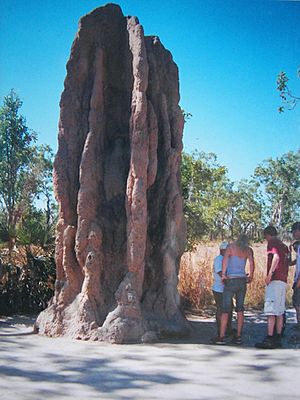Natural environment facts for kids
The natural environment is everything around us that wasn't made by people. It includes all living things, like plants and animals, and non-living things, like rocks, water, and air. When we talk about the natural environment, we usually mean nature here on Earth.

The natural environment is made of different parts:
- Natural systems: These are places and things that haven't been changed much by humans. They include all the plants, tiny living things called microorganisms, soil, rocks, the air around Earth, and natural events like storms.
- Natural resources and events: These are things like climate, air, water, and energy that are found everywhere. They also include natural events like lightning or the way magnetism works.
There's also the built environment. This is where people have changed nature to create cities, farms, and other human-made places.
Contents
What Makes Up Our Natural World?
The natural world is full of amazing things, both living and non-living.
Living Parts of Nature
The living parts of the natural environment are all the plants, animals, and tiny organisms.
- Plants: From giant trees to tiny mosses, plants are a huge part of our natural world. They help make the air we breathe and provide food for many animals.
- Animals: Animals come in all shapes and sizes, from tiny insects to huge whales. They live in different natural places, like forests, deserts, and oceans.
- Microorganisms: These are living things so small you need a microscope to see them. They live everywhere, in soil, water, and even inside us! They play a big role in keeping nature healthy.
Non-Living Parts of Nature
The non-living parts of the natural environment are just as important.
- Air and Atmosphere: The air we breathe is part of the natural environment. The Earth's atmosphere is a layer of gases that surrounds our planet. It protects us from the sun's harmful rays and helps keep the Earth warm.
- Water: Water is essential for all life. It's found in oceans, rivers, lakes, and even underground. The way water moves around the Earth is a natural process.
- Land and Rocks: The land we stand on, including mountains, valleys, and deserts, is a key part of nature. Rocks and soil are also natural and provide homes for many living things.
- Climate and Weather: The climate is the usual weather in a place over a long time. Weather includes things like rain, snow, and sunshine. These are natural events that shape our environment.
- Energy and Forces: Natural energy comes from things like the sun or heat from inside the Earth. Forces like magnetism and electric charge are also natural parts of our world.
Protecting Our Natural Environment
It's very important to protect our natural environment. Many human activities can harm nature, like air pollution or cutting down too many trees. When we protect natural places, we help keep plants and animals safe and ensure that future generations can enjoy the beauty of nature.
Images for kids
-
Land management has preserved the natural characteristics of Hopetoun Falls, Australia while allowing ample access for visitors.
-
An image of the Sahara desert from satellite. It is the world's largest hot desert and third-largest desert after the polar deserts.
-
Coral reefs have significant marine biodiversity.
-
Rocky stream in the U.S. state of Hawaii
-
Lácar Lake, of glacial origin, in the province of Neuquén, Argentina
-
A swamp area in Everglades National Park, Florida, US.
-
Atmospheric gases scatter blue light more than other wavelengths, creating a blue halo when seen from space.
-
A view of Earth's troposphere from an airplane
-
Lightning is an atmospheric discharge of electricity accompanied by thunder, which occurs during thunderstorms and certain other natural conditions.
-
The retreat of glaciers since 1850 of Aletsch Glacier in the Swiss Alps (situation in 1979, 1991 and 2002), due to global warming
-
Another view of the Aletsch Glacier in the Swiss Alps, which because of global warming has been decreasing
-
Worldwide climate classifications map -
A rainbow is an optical and meteorological phenomenon that causes a spectrum of light to appear in the sky when the Sun shines onto droplets of moisture in the Earth's atmosphere.
-
There are many plant species on the planet.
-
An example of the many animal species on the Earth
-
Rainforests often have a great deal of biodiversity with many plant and animal species. This is the Gambia River in Senegal's Niokolo-Koba National Park.
-
Old-growth forest and a creek on Larch Mountain, in the U.S. state of Oregon
-
Map of terrestrial biomes classified by vegetation
-
Chloroplasts conduct photosynthesis and are found in plant cells and other eukaryotic organisms. These are chloroplasts visible in the cells of Plagiomnium affine — many-fruited thyme-moss.
-
A conifer forest in the Swiss Alps (National Park)
-
The Ahklun Mountains and the Togiak Wilderness within the Togiak National Wildlife Refuge in the U.S. state of Alaska
-
A view of wilderness in Estonia
-
Before flue-gas desulfurization was installed, the air-polluting emissions from this power plant in New Mexico contained excessive amounts of sulfur dioxide.
-
Amazon rainforest in Brazil. The tropical rainforests of South America contain the largest diversity of species on Earth, including some that have evolved within the past few hundred thousand years.
See also
 In Spanish: Medio ambiente natural para niños
In Spanish: Medio ambiente natural para niños

























